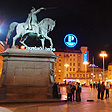ZAGREB – CROATIA
Capital City of Beauties at a Bargain
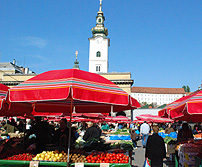 Zagreb is a city of
beauties and contrasts, with the style of Vienna, but without the Euro
prices. For those travelers seeking the grandness
of old Europe on a budget, Prague has been discovered and no longer the
bargain it once was, so have a go at Zagreb. Croatia still has the Kuna
and may be a while before it makes it into the Euro zone, and with the
current troubles of the euro countries, may be glad to be on its own, and
still a boon to the adventurous tourist on a budget. While the Dalmatian
coast of southern Croatia has become the “new Ibiza” of crowded
beaches (or perhaps the Dubrovnic of old), the capital city remains a destination
less traveled.
Zagreb is a city of
beauties and contrasts, with the style of Vienna, but without the Euro
prices. For those travelers seeking the grandness
of old Europe on a budget, Prague has been discovered and no longer the
bargain it once was, so have a go at Zagreb. Croatia still has the Kuna
and may be a while before it makes it into the Euro zone, and with the
current troubles of the euro countries, may be glad to be on its own, and
still a boon to the adventurous tourist on a budget. While the Dalmatian
coast of southern Croatia has become the “new Ibiza” of crowded
beaches (or perhaps the Dubrovnic of old), the capital city remains a destination
less traveled.
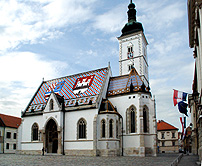 A
tour of Zagreb shows the signs of its many ages of change, from medieval
beginnings
to the divide between east and west under the Austro-Hungarian
Empire to the socialist era of the now vanished Yugoslavia. The modern
city of nearly a million people is backed between the mountain of Medvednica
which protects it from the cold northern winds and the broad plain of the
Sava River. There were earlier settlements of the Celts and Romans, but
the city of the middle-ages was formed by settlements on two hills, Gradec,
the upper town and the lower town of Kaptol, each
at odds with one another for a couple of centuries. The two old medieval
towns
are
divided
by the
Kamenita Vrata gate, guarded on the lower side by a statue of St George
astride his steed over a defeated pink dragon. The gate was burned in the
early 1700s, but an icon of the Virgin Mary remained untouched, known as
Our Lady of Kamenita Vrata, the patron saint of Zagreb.
A
tour of Zagreb shows the signs of its many ages of change, from medieval
beginnings
to the divide between east and west under the Austro-Hungarian
Empire to the socialist era of the now vanished Yugoslavia. The modern
city of nearly a million people is backed between the mountain of Medvednica
which protects it from the cold northern winds and the broad plain of the
Sava River. There were earlier settlements of the Celts and Romans, but
the city of the middle-ages was formed by settlements on two hills, Gradec,
the upper town and the lower town of Kaptol, each
at odds with one another for a couple of centuries. The two old medieval
towns
are
divided
by the
Kamenita Vrata gate, guarded on the lower side by a statue of St George
astride his steed over a defeated pink dragon. The gate was burned in the
early 1700s, but an icon of the Virgin Mary remained untouched, known as
Our Lady of Kamenita Vrata, the patron saint of Zagreb.
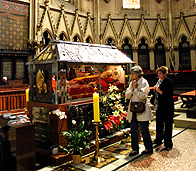 The
first written mention of Zagreb dates to 1094 when Hungarian King Ladislav
granted the Catholic
Diocese of Kaptol on his route to the Adriatic
coast. The center of the lower city is dominated by the Cathedral of Zagreb
where the old city walls once surrounded the city. As it stand today the
cathedral is an impressive neo-gothic reconstruction of towering spires.
The original which dates back to the 12th Century was nearly destroyed
by the invasion of the Tartars in the 1300s, and further damaged by an
earthquake, rebuilt in 1880. One of the most unique features of the cathedral
is the burial repose of Archbishop Alojzije Stepinac, who lies embalmed
and preserved inside, behind the altar (see Zagreb
Cathedral).
The
first written mention of Zagreb dates to 1094 when Hungarian King Ladislav
granted the Catholic
Diocese of Kaptol on his route to the Adriatic
coast. The center of the lower city is dominated by the Cathedral of Zagreb
where the old city walls once surrounded the city. As it stand today the
cathedral is an impressive neo-gothic reconstruction of towering spires.
The original which dates back to the 12th Century was nearly destroyed
by the invasion of the Tartars in the 1300s, and further damaged by an
earthquake, rebuilt in 1880. One of the most unique features of the cathedral
is the burial repose of Archbishop Alojzije Stepinac, who lies embalmed
and preserved inside, behind the altar (see Zagreb
Cathedral).
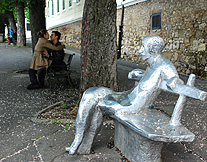 In 1242, the
Hungarian King Bela IV escaped the ravishing Tartar horde from his capital
in Budapest to the
protection of the hilltop Gradec, and in gratitude for saving his bacon,
granted the upper city a charter as a free royal city. The two old towns
are divided by the mills of the Medvešcak creek, now a narrow street
of shops and restaurants. The center of the old upper city is the beautiful
old town hall with its colorful tile roof with the coat of arms of Croatia
and the magnificent Baroque art of St Catherine's church. The panorama
of the city can be viewed from the Strossmayer Promenade, below the medieval
Lotršcak Tower where a cannon blasts every day at noon, from a bench
next to the silver statue of the poet Anton Gustav Matoš, a popular
romantic spot, reached by stairs or the funicular.
In 1242, the
Hungarian King Bela IV escaped the ravishing Tartar horde from his capital
in Budapest to the
protection of the hilltop Gradec, and in gratitude for saving his bacon,
granted the upper city a charter as a free royal city. The two old towns
are divided by the mills of the Medvešcak creek, now a narrow street
of shops and restaurants. The center of the old upper city is the beautiful
old town hall with its colorful tile roof with the coat of arms of Croatia
and the magnificent Baroque art of St Catherine's church. The panorama
of the city can be viewed from the Strossmayer Promenade, below the medieval
Lotršcak Tower where a cannon blasts every day at noon, from a bench
next to the silver statue of the poet Anton Gustav Matoš, a popular
romantic spot, reached by stairs or the funicular.
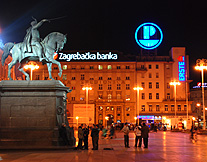 The city spread
in the later Renaissance and Imperial age around the main square of Ban
Josip
Jelacic, the heart of the city’s modern cultural
life, with the dance of trolley trains passing the statue of the historic
Croatian national hero on his horse, erected in 1866. Jelacic lead the
charge to end feudal serfdom in the country, allowing popular representation
in the Parliament (Sabor), though his pose is from an earlier military
assault on the Ottoman Turks to the east (see Castle
Durdevac & the Rooster). The city
gets its name from the legend of a thirsty soldier who asked a girl named
Manda
to ladle (zagrabiti) him some water from a spring. This became the Mandusevac
Fountain in the center of the square, and the city became Zagreb. A statue
to Croatia’s more technical hero Nikola Tesla, can be found a few
blocks off the Ban Josip Jelacic square, past the classic Hotel Dubrovnik,
on the street named for him, Teslina. Sit in an outdoor cafe or the bars
which fill up when the sun goes down and university students fill the streets
with vibrant energy.
The city spread
in the later Renaissance and Imperial age around the main square of Ban
Josip
Jelacic, the heart of the city’s modern cultural
life, with the dance of trolley trains passing the statue of the historic
Croatian national hero on his horse, erected in 1866. Jelacic lead the
charge to end feudal serfdom in the country, allowing popular representation
in the Parliament (Sabor), though his pose is from an earlier military
assault on the Ottoman Turks to the east (see Castle
Durdevac & the Rooster). The city
gets its name from the legend of a thirsty soldier who asked a girl named
Manda
to ladle (zagrabiti) him some water from a spring. This became the Mandusevac
Fountain in the center of the square, and the city became Zagreb. A statue
to Croatia’s more technical hero Nikola Tesla, can be found a few
blocks off the Ban Josip Jelacic square, past the classic Hotel Dubrovnik,
on the street named for him, Teslina. Sit in an outdoor cafe or the bars
which fill up when the sun goes down and university students fill the streets
with vibrant energy.
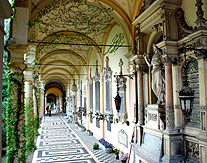 Zagreb's grand
larger buildings laid out in a grid around the Green Horseshoe square
is from the industrial age of the 19th Century when the railroad
brought industry to the Croatian capital, with neo-Baroque facades of
bright imperial yellow colors and lines of wild chestnut trees. Zagreb
is a city filled with green spaces, some of planned as parks, some the
result of the socialist era, which can best be seen on the road from
the airport into the city, where tall indistinctive apartment buildings
spread along the busy roadway. One
of the more fascinating sights of the imperial days before World War
I ended the golden age,
just outside the city, is one of Europe’s
most beautiful cemeteries, Mirogoj, with its elegant grand domes and long
arcades of tombs designed by Hermann Bolle, as much a green park and open-air
art gallery as it is the resting place for public figures and former wealthy
families.
Zagreb's grand
larger buildings laid out in a grid around the Green Horseshoe square
is from the industrial age of the 19th Century when the railroad
brought industry to the Croatian capital, with neo-Baroque facades of
bright imperial yellow colors and lines of wild chestnut trees. Zagreb
is a city filled with green spaces, some of planned as parks, some the
result of the socialist era, which can best be seen on the road from
the airport into the city, where tall indistinctive apartment buildings
spread along the busy roadway. One
of the more fascinating sights of the imperial days before World War
I ended the golden age,
just outside the city, is one of Europe’s
most beautiful cemeteries, Mirogoj, with its elegant grand domes and long
arcades of tombs designed by Hermann Bolle, as much a green park and open-air
art gallery as it is the resting place for public figures and former wealthy
families.
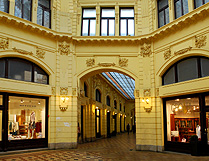 The
city is dotted with fresh produce food markets, tucked into its squares
and parks, but the most famed and largest is the Dolac Market, near the
cathedral with the wide square adorned with Red Sestine umbrellas protecting
the daily sellers of fresh fruit, vegetables, meats, fish and flowers from
the sun or rain. For shopping, Zagreb
is a city where you can browse for antiques, sweets or current fashions
in small traditional shops or contemporary boutiques on the most
famous shopping street , the Ilica, a grand golden indoor arcade
of the 19th Century. Find a souvenir of two of the inventions Croatia introduced
to the world, the fountain pen and the necktie, or the traditional biscuit
cake of honey dough, the Licitar, in the form of a red heart - perfect
a city known for its beautiful girls. © Bargain
Travel Europe
The
city is dotted with fresh produce food markets, tucked into its squares
and parks, but the most famed and largest is the Dolac Market, near the
cathedral with the wide square adorned with Red Sestine umbrellas protecting
the daily sellers of fresh fruit, vegetables, meats, fish and flowers from
the sun or rain. For shopping, Zagreb
is a city where you can browse for antiques, sweets or current fashions
in small traditional shops or contemporary boutiques on the most
famous shopping street , the Ilica, a grand golden indoor arcade
of the 19th Century. Find a souvenir of two of the inventions Croatia introduced
to the world, the fountain pen and the necktie, or the traditional biscuit
cake of honey dough, the Licitar, in the form of a red heart - perfect
a city known for its beautiful girls. © Bargain
Travel Europe
Find best hotel and travel deals in Croatia on TripAdvisor
Web
Info
Zagreb
Tourism
These articles are copyrighted and the sole property of Bargain Travel Europe and WLPV, LLC. and may not be copied or reprinted without permission.
SEE ALSO:
OSIJEK
ON THE DRAVA
TRAKOSCAN
CASTLE - ZAGORJE
HOTEL CASTLE GJALSKI - KRAPINA-ZAGORJE

